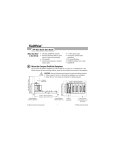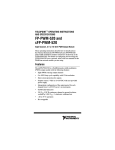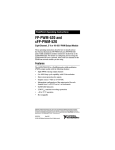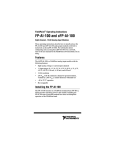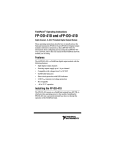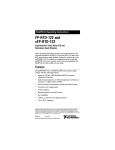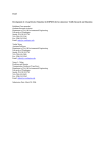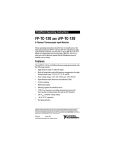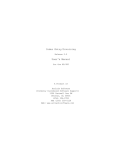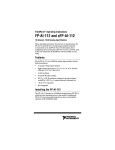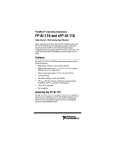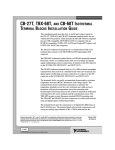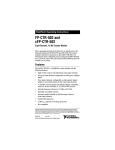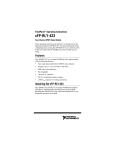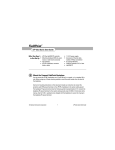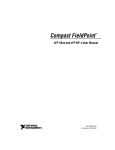Download FP-SG-140 AND CFP-SG-140
Transcript
FieldPoint Operating Instructions FP-SG-140 AND CFP-SG-140 Eight-Channel Strain-Gauge Input Modules These operating instructions describe how to install and use the FP-SG-140 and cFP-SG-140 strain-gauge input modules (referred to inclusively as the [c]FP-SG-140). For information about configuring and accessing the [c]FP-SG-140 over a network, refer to the user manual for the FieldPoint network module you are using. Features The [c]FP-SG-140 is a FieldPoint strain-gauge input module with the following features: • Internal support for full- and half-bridge configurations with programmable bridge completion • Programmable excitation for each channel: 2.5, 5, or 10 V • Four input ranges: ±3.5, ±7.5, ±30, and ±60 mV/V with overranging • Three filter settings: 15, 60, and 240 Hz • 16-bit resolution • 2,300 Vrms transient overvoltage protection between the inter-module communication bus and the I/O channels • –40 to 70 °C operation • Hot plug-and-play FieldPoint™, National Instruments™, NI™, and ni.com™ are trademarks of National Instruments Corporation. Product and company names mentioned herein are trademarks or trade names of their respective companies. For patents covering National Instruments products, refer to the appropriate location: Help»Patents in your software, the patents.txt file on your CD, or ni.com/patents. 323346A-01 October 2002 © 2002 National Instruments Corp. All rights reserved. Installing the FP-SG-140 The FP-SG-140 mounts on a FieldPoint terminal base (FP-TB-x). Hot plug-and-play enables you to install the FP-SG-140 onto a powered terminal base without disturbing the operation of other modules or terminal bases. The FP-SG-140 receives operating power from the terminal base. To install the FP-SG-140, refer to Figure 1 and complete the following steps: 1. Slide the terminal base key to either position X, used for any module, or position 1, used for the FP-SG-140. 2. Align the FP-SG-140 alignment slots with the guide rails on the terminal base. 3. Press firmly to seat the FP-SG-140 on the terminal base. When the module is firmly seated, the terminal base latch locks it into place. Key Latch Alignment Slot Guide Rails I/O Module Terminal Base Figure 1. Installing the Module Installing the cFP-SG-140 The cFP-SG-140 mounts on a Compact FieldPoint backplane (cFP-BP-x). Hot plug-and-play enables you to install the cFP-SG-140 onto a powered backplane without disturbing the operation of other modules or connector blocks. The cFP-SG-140 receives operating power from the backplane. FP-SG-140 and cFP-SG-140 2 ni.com To install the cFP-SG-140, refer to Figure 2 and complete the following steps: 1. Align the captive screws on the cFP-SG-140 with the holes on the backplane. The alignment keys on the cFP-SG-140 prevent backward insertion. 2. Press firmly to seat the cFP-SG-140 on the backplane. 3. Using a number 2 Phillips screwdriver with a shank of at least 64 mm (2.5 in.) length, tighten the captive screws to 1.1 N ⋅ m (10 lb ⋅ in.) of torque. The nylon coating on the screws prevents them from loosening. 5 2 1 4 5 4 3 1 cFP Backplane 2 cFP Controller Module 3 cFP-SG-140 4 Captive Screws 5 Screw Holes Figure 2. Installing the cFP-SG-140 © National Instruments Corp. 3 FP-SG-140 and cFP-SG-140 Wiring the [c]FP-SG-140 The following sections show how to wire strain gauges to the [c]FP-SG-140 using the terminals on the FP-TB-x terminal base or cFP-CB-x connector block. The four terminals used for strain gauges are Vexc, COM, Vin+, and Vin–. Table 1 lists the terminal assignments for the signals associated with each channel. Table 1. Terminal Assignments Channel Vin+ Vin– Vexc COM 0 1 2 17 18 1 3 4 19 20 2 5 6 21 22 3 7 8 23 24 4 9 10 25 26 5 11 12 27 28 6 13 14 29 30 7 15 16 31 32 The eight input channels of the [c]FP-SG-140 share a common ground that is isolated from the other modules of the FieldPoint system. The COM terminals of all the channels and the C terminals are all connected together. If you are using shielded wiring, you can connect the shield to the COM terminal, but only if the shield is not connected to the strain-gauge circuit. Connecting Sensors to the Input Channels Each channel pulses a voltage between the Vexc and COM terminals. The Vin+ and Vin– terminals measure the voltage generated across the output terminals of the strain-gauge bridge. Each channel is filtered, then sampled by an analog-to-digital converter. Figure 3 shows the input circuit for a single channel. FP-SG-140 and cFP-SG-140 4 ni.com Vexc Vin+ 16-Bit ADC Vin– + – Excitation Voltage COM [c]FP-SG-140 Figure 3. [c]FP-SG-140 Input Circuit Connecting a Full-Bridge Strain Gauge Connect the positive output to Vin+ and the negative output to Vin–. Connect the positive excitation terminal to Vexc and the negative excitation terminal to COM. Refer to Figure 4. Full-Bridge Strain Gauge Vexc Vin+ Input Circuitry Vin– + – Excitation Voltage COM [c]FP-SG-140 Figure 4. Connecting a Full-Bridge Strain Gauge to One Channel Connecting a Half-Bridge Strain Gauge Connect the positive output to the Vin+ terminal and do not connect anything to the Vin– terminal. Connect the positive output to Vin+ and the negative output to Vin–. Connect the positive excitation terminal to Vexc and the negative excitation terminal to COM. Refer to Figure 4. © National Instruments Corp. 5 FP-SG-140 and cFP-SG-140 Vexc Vin+ Half-Bridge Strain Gauges Vin– Input Circuitry + – Excitation Voltage COM [c]FP-SG-140 Figure 5. Connecting a Half-Bridge Strain Gauge to One Channel For any channel connected to a half-bridge strain gauge, select Half-Bridge Completion ON in the Channel Configuration dialog box in the FieldPoint software. Connecting a Quarter-Bridge Strain Gauge For quarter-bridge sensors, you need an external resistor with the same resistance as the quarter-bridge strain gauge. The accuracy of your measurements depends on matching the value of this completion resistor to the nominal resistance value of the strain gauge. Connect the positive output of the strain gauge to Vin+, connect the positive excitation terminal of the strain gauge to Vexc, and connect the completion resistor between Vin+ and COM. In the FieldPoint software, select Half-Bridge Completion ON. Vexc Quarter-Bridge Strain Gauges External Completion Resistor Vin+ Vin– Input Circuitry + – Excitation Voltage COM [c]FP-SG-140 Figure 6. Connecting a Quarter-Bridge Strain Gauge to One Channel FP-SG-140 and cFP-SG-140 6 ni.com Configuring Input Channels After you connect the strain gauges, configure the input channels in the FieldPoint software. Selecting an Input Range To prevent inaccurate readings, choose an input range such that the signal you are measuring does not exceed either end of the range. Overranging allows the [c]FP-SG-140 to measure a little beyond the nominal value of each input range. For example, the actual measurement limit of the ±3.5 mV/V range is ±3.90625 mV/V. Overranging enables the [c]FP-SG-140 to compensate for field devices with span errors of up to 12%. Also, with the overranging feature, a noisy signal near full scale does not create rectification errors. Channel Attributes The Channel Attributes panel has an Attribute pulldown menu from which you choose the attribute you want to configure: Noise Rejection, Excitation Voltage, or Half-Bridge Completion. Noise Rejection Each analog input channel has a software-enabled comb filter that you can set to reject frequencies above 15, 60, or 240 Hz. Excitation Voltage You can choose 2.5, 5, or 10 V excitation for each channel. The current limit is 21 mA. Table 2 shows the minimum bridge resistance at each excitation voltage level. Table 2. Minimum Bridge Resistance Excitation Voltage Minimum Bridge Resistance 2.5 V 120 Ω 5V 240 Ω 10 V 477 Ω If the bridge resistance is lower than the minimum value for the excitation voltage level, the readings are not valid and the red LED for the channel lights, indicating an overcurrent error. © National Instruments Corp. 7 FP-SG-140 and cFP-SG-140 Half-Bridge Completion You can enable or disable half-bridge completion for each channel. Enable half-bridge completion for half-bridge and quarter-bridge sensors. When a channel is configured with the Half-Bridge Completion ON attribute value, the Vin– input is internally disconnected from the screw terminal and connected to a completion circuit. Using Measured Values The [c]FP-SG-140 reports measurements in units of mV/V (millivolts per volt of excitation), allowing the [c]FP-SG-140 to take measurements from a wide variety of transducers, such as load cells and pressure sensors. To convert measurements from mV/V to the physical units of a particular transducer, multiply by a constant as shown in the following sections. Converting to Microstrain Strain is measured in units of microstrain (µε). The constant you use to convert readings from mV/V to µε depends on whether you are using a full-, half-, or quarter-bridge strain-gauge circuit. If you are using a full-bridge circuit similar to the one in Figure 4, you can convert readings from mV/V to µε by multiplying the readings by the following constant: –1 constant = 1000 × -------GF where GF is the gauge factor of the strain gauges. The gauge factor is listed in the strain gauge data sheet. For example, assume a full-bridge circuit has strain gauges with a gauge factor of 2.03. Using the previous constant equation, the constant is –492.6108, as shown in the following calculation: –1 1000 × --------------- = – 492.6108 ( 2.03 ) If the [c]FP-SG-140 reads 0.75 mV/V, the strain in units of microstrain is –369.5 µε, as shown in the following calculations: reading in mV/V × constant = reading in microstrain (0.75) × (–492.6108) = –369.5 µε FP-SG-140 and cFP-SG-140 8 ni.com If you are using a half-bridge circuit similar to the one in Figure 5, you can convert readings from mV/V to µε by multiplying the readings by the following constant: –2 constant = 1000 × -------GF If you are using a quarter-bridge circuit similar to the one in Figure 6, you can convert readings from mV/V to µε by multiplying the readings by the following constant: –4 constant = 1000 × -------GF For more information about strain gauges and how the equations in this section are derived, refer to NI Application Note 078, Strain Gauge Measurement – A Tutorial, available at ni.com. Converting to Other Physical Units If you use the [c]FP-SG-140 to measure the output of other transducers, such as load cells or pressure transducers, you can convert measurements from mV/V to other physical units such as force or pressure. Load cells are specified by maximum voltage output at maximum load capacity. To convert load cell readings from the [c]FP-SG-140 to units of force or pressure, multiply the readings by the following constant: constant = FullScaleCapacity -------------------------------------------------FullScaleOutput where FullScaleOutput is the maximum voltage output of the load cell in mV/V, and FullScaleCapacity is the maximum capacity of the load cell in units of force or pressure. For example, if you are using a load cell with a maximum capacity of 1,000 lb and a maximum output of 2 mV/V, the constant is 500, as shown in the following calculation: 1000 ------------ = 500 2 This means the transducer outputs 1 mV/V per 500 lb of force applied to it. To convert readings to lb, multiply the output of the [c]FP-SG-140 by 500. If the [c]FP-SG-140 has a reading of © National Instruments Corp. 9 FP-SG-140 and cFP-SG-140 0.75 mV/V, the force in pounds that is applied to the load cell is 375 lb, as shown in the following calculation: 0.75 × 500 = 375 lb Status Indicators Figure 7 shows the [c]FP-SG-140 status indicators. Figure 7. Status Indicators The [c]FP-SG-140 has two green status LEDs, POWER and READY. After you insert the [c]FP-SG-140 into a terminal base or backplane and apply power to the connected network module, the green POWER indicator lights and the [c]FP-SG-140 informs the network module of its presence. When the network module recognizes the [c]FP-SG-140, it sends initial configuration information to the [c]FP-SG-140. After receiving this initial information, the green READY indicator lights and the [c]FP-SG-140 is in normal operating mode. In addition to the green POWER and READY indicators, each channel has a numbered, red LED that indicates overcurrent conditions. When a transducer draws more than 21 mA from the excitation terminal, the red LED for that channel lights and an overcurrent error is reported to the network module. This also occurs if the Vexc output is shorted to ground. Upgrading the FieldPoint Firmware You may need to upgrade the FieldPoint firmware when you add new I/O modules to the FieldPoint system. For information on determining which firmware you need and how to upgrade, go to ni.com/info and enter fpmatrix. Isolation and Safety Guidelines Read the following information before attempting to connect the [c]FP-SG-140 to any circuits that may contain hazardous voltages. Caution FP-SG-140 and cFP-SG-140 10 ni.com This section describes the isolation of the [c]FP-SG-140 and its compliance with international safety standards. The field wiring connections are isolated from the backplane and the inter-module communication bus. The isolation is provided by the module, which has optical and galvanic isolation barriers designed and tested to protect against transient fault voltages of up to 2,300 Vrms. Follow these guidelines to ensure a safe total system: • The [c]FP-SG-140 has a safety isolation barrier between the I/O channels and the inter-module communication bus. There is no isolation between channels unless otherwise noted. If any of the channels on a module are wired at a hazardous potential, make sure that all other devices or circuits connected to that module are properly insulated from human contact. • Do not share the external supply voltages (the V and C terminals) with other devices (including other FieldPoint devices), unless those devices are isolated from human contact. • For Compact FieldPoint, you must connect the protective earth (PE) ground terminal on the cFP-BP-x backplane to the system safety ground. The backplane PE ground terminal has the following symbol stamped beside it: . Connect the backplane PE ground terminal to the system safety ground using 14 AWG (1.6 mm) wire with a ring lug. Use the 5/16 in. panhead screw shipped with the backplane to secure the ring lug to the backplane PE ground terminal. • As with any hazardous voltage wiring, make sure that all wiring and connections meet applicable electrical codes and commonsense practices. Mount terminal bases and backplanes in an area, position, or cabinet that prevents accidental or unauthorized access to wiring that carries hazardous voltages. • Operate the [c]FP-SG-140 only at or below Pollution Degree 2. Pollution Degree 2 means that only nonconductive pollution occurs in most cases. Occasionally, however, a temporary conductivity caused by condensation must be expected. • Refer to the FieldPoint product label for regulatory certification under hazardous location standards. If the FieldPoint product is not certified for operation in hazardous locations, do not operate it in an explosive atmosphere or where there may be flammable gases or fumes. © National Instruments Corp. 11 FP-SG-140 and cFP-SG-140 Specifications These specifications are typical for the range –40 to 70 °C unless otherwise noted. Input Characteristics Number of channels.......................... 8 ADC resolution................................. 16 bits Type of ADC..................................... Delta-sigma Input signal ranges (software-selectable per channel) Nominal With Overranging ±3.5 mV/V ±3.90625 mV/V ±7.5 mV/V ±7.8125 mV/V ±30 mV/V ±31.25 mV/V ±60 mV/V ±62.5 mV/V Filter settings .................................... 15, 60, 240 Hz Excitation voltage ............................. 2.5, 5, 10 V, current is limited to 21 mA per channel Pulse frequency and width Filter Setting (Hz) Pulse Width (ms) Pulse Frequency (s) 15 324 1.15 60 116 0.95 240 70 0.90 FP-SG-140 and cFP-SG-140 12 ni.com Figure 8 shows how the pulse frequency and width are defined. 1 2 1 Pulse Frequency 2 Pulse Width Figure 8. Pulse Width and Pulse Frequency All-channel update rate Filter Setting (Hz) Update Rate (s) 15 1.15 60 0.95 240 0.90 Input impedance................................ 20 MΩ Offset error 15 to 35 °C ................................. 7.6 µV typ, 28 µV max –40 to 70 °C ............................... 50 µV typ, 140 µV max Gain error 15 to 35 °C ................................. 0.06% of full scale (fs) –40 to 70 °C ............................... 0.4% fs Input noise (60 Hz filter) ±3.5 mV/V.................................. ±3 LSB peak-to-peak ±7.5 mV/V.................................. ±2 LSB peak-to-peak Other ranges ............................... ±1 LSB peak-to-peak Physical Characteristics Indicators .......................................... Green POWER and READY indicators; eight red overcurrent indicators © National Instruments Corp. 13 FP-SG-140 and cFP-SG-140 Weight FP-SG-140.................................. 140 g (4.8 oz) cFP-SG-140................................ 110 g (3.7 oz) Power Requirements Power from network module ............ 1 W Isolation Voltage Channel-to-channel isolation ............ No isolation between channels Transient overvoltage........................ 2,300 Vrms Environmental FieldPoint modules are intended for indoor use only. For outdoor use, they must be mounted inside a sealed enclosure. Operating temperature ...................... –40 to 70 °C Storage temperature .......................... –55 to 85 °C Humidity ........................................... 10 to 90% RH, noncondensing Maximum altitude............................. 2,000 m Pollution Degree .............................. 2 Shock and Vibration Operating shock (IEC 68-2-27) cFP-SG-140..................................50 g, 3 ms half sine, 3 shocks; 30 g, 11 ms half sine, 3 shocks Operating vibration, random (IEC 60068-2-34) FP-SG-140.................................. 10–500 Hz, 2.2 grms cFP-SG-140................................ 10–500 Hz, 5 grms Operating vibration, sinusoidal (IEC 60068-2-6) [c]FP-SG-140 ............................. 10–500 Hz, 5 g Safety The [c]FP-SG-140 is designed to meet the requirements of the following standards for safety and electrical equipment for measurement, control, and laboratory use. • EN 61010-1, IEC 61010-1 FP-SG-140 and cFP-SG-140 14 ni.com • UL 3121-1 • CAN/CSA C22.2 No. 1010.1 For certifications under regulatory standards, including hazardous location standards, refer to the product label or to ni.com. Electromagnetic Compatibility CE, C-Tick, and FCC Part 15 (Class A) Compliant Electromagnetic emissions ............... EN 55011 Class A at 10 m FCC Part 15A above 1 GHz Electromagnetic immunity................ Evaluated to EN 61326: 1997/A1: 1998, Table 1 For full EMC compliance, you must operate this device with shielded cabling. Refer to the Declaration of Conformity (DoC) for this product for any additional regulatory compliance information. To obtain the DoC for this product, click Declaration of Conformity at ni.com/hardref.nsf/. For FCC regulatory statements, refer to the Read Me First document that accompanies this product. Note Mechanical Dimensions Figure 9 shows the mechanical dimensions of the FP-SG-140 installed on a terminal base. Dimensions are given in millimeters [inches]. If you are using the cFP-SG-140, refer to the Compact FieldPoint controller user manual for the dimensions and cabling clearance requirements of the Compact FieldPoint system. 107.19 [4.22] 109.5 [4.31] 91.44 [3.60] Figure 9. FP-SG-140 Mechanical Dimensions © National Instruments Corp. 15 FP-SG-140 and cFP-SG-140 Where to Go for Support For more information about setting up the FieldPoint system, refer to these National Instruments documents: • FieldPoint network module user manual • Other FieldPoint I/O module operating instructions • FieldPoint terminal base operating instructions Go to ni.com/support for the most current manuals, examples, and troubleshooting information. For telephone support in the United States, create your service request at ni.com/ask and follow the calling instructions or dial 512 795 8248. For telephone support outside the United States, contact your local branch office: Australia 03 9879 5166, Austria 0662 45 79 90 0, Belgium 02 757 00 20, Brazil 55 11 3262 3599, Canada (Calgary) 403 274 9391, Canada (Montreal) 514 288 5722, Canada (Ottawa) 613 233 5949, Canada (Québec) 514 694 8521, Canada (Toronto) 905 785 0085, China 86 21 6555 7838, Czech Republic 02 2423 5774, Denmark 45 76 26 00, Finland 09 725 725 11, France 01 48 14 24 24, Germany 089 741 31 30, Greece 01 42 96 427, Hong Kong 2645 3186, India 91 80 4190000, Israel 03 6393737, Italy 02 413091, Japan 03 5472 2970, Korea 02 3451 3400, Malaysia 603 9596711, Mexico 001 800 010 0793, Netherlands 0348 433466, New Zealand 09 914 0488, Norway 32 27 73 00, Poland 22 3390 150, Portugal 210 311 210, Russia 095 238 7139, Singapore 65 6 226 5886, Slovenia 3 425 4200, South Africa 11 805 8197, Spain 91 640 0085, Sweden 08 587 895 00, Switzerland 056 200 51 51, Taiwan 02 2528 7227, United Kingdom 01635 523545 *323346A-01* 323346A-01 Oct02
















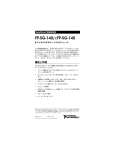
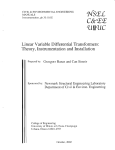
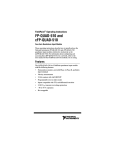
![[c]FP-DO-401 Operating Instructions](http://vs1.manualzilla.com/store/data/005693758_1-4b10a2df6965457ee651014d1377996a-150x150.png)
